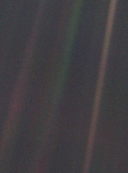In 1990, the Voyager 1 space probe, at the request of Carl Sagan, turned its camera around to capture a photo of Earth from a record distance of 10 billion kilometers, just before leaving the solar system after completing its primary mission.
This photo (displayed on the left), famously known as the "Pale Blue Dot," shows Earth occupying just a fraction of a pixel (0.12 pixels).
Carl Sagan later reflected on the profound significance of this photograph in the passage below.
This passage always lifts my spirits and is one of my favorite (page-length) quotes!
Photo credit: Voyager 1, Public domain, via Wikimedia Commons.
"From this distant vantage point, the Earth might not seem of any particular interest.
But for us, it's different.
Consider again that dot.
That's here.
That's home.
That's us.
On it everyone you love, everyone you know, everyone you ever heard of, every human being who ever was, lived out their lives.
The aggregate of our joy and suffering, thousands of confident religions, ideologies, and economic doctrines, every hunter and forager, every hero and coward, every creator and destroyer of civilization, every king and peasant, every young couple in love, every mother and father, hopeful child, inventor and explorer, every teacher of morals, every corrupt politician, every 'superstar,'' every 'supreme leader,' every saint and sinner in the history of our species lived there – on a mote of dust suspended in a sunbeam.
The Earth is a very small stage in a vast cosmic arena.
Think of the rivers of blood spilled by all those generals and emperors so that in glory and triumph they could become the momentary masters of a fraction of a dot.
Think of the endless cruelties visited by the inhabitants of one corner of this pixel on the scarcely distinguishable inhabitants of some other corner.
How frequent their misunderstandings, how eager they are to kill one another, how fervent their hatreds.
Our posturings, our imagined self-importance, the delusion that we have some privileged position in the universe, are challenged by this point of pale light.
Our planet is a lonely speck in the great enveloping cosmic dark.
In our obscurity, in all this vastness, there is no hint that help will come from elsewhere to save us from ourselves.
The Earth is the only world known, so far, to harbor life.
There is nowhere else, at least in the near future, to which our species could migrate.
Visit, yes. Settle, not yet.
Like it or not, for the moment, the Earth is where we make our stand.
It has been said that astronomy is a humbling and character-building experience.
There is perhaps no better demonstration of the folly of human conceits than this distant image of our tiny world.
To me, it underscores our responsibility to deal more kindly with one another and to preserve and cherish the pale blue dot, the only home we've ever known."
— Carl Sagan, Pale Blue Dot: A Vision of the Human Future in Space, 1994 [book]
Personal
When I am not actively thinking about research, I enjoy solving puzzles, especially those with mathematical and/or linguistics flavor.
This is largely a remnant hobby from high-school days of participating in national math, physics, and astronomy olympiad training camps (which, although I did not manage to secure a spot on the national teams in either, remains one of my favorite experiences in life).
At other times, I get a kick out of reading about and discussing cosmology, physics, and science fiction in general.
This is largely a consequence of being the only son of two physics professors.
Though a good fraction of our conversations drift and end the same way.
When I have poured enough material onto my brain, I love taking long, leisurely walks or long, hot showers, often late at night, to ponder and ruminate about the things I read for effective digestion.
It is not just math and science that I enjoy, though.
I also enjoy watching films.
In the past, I watched them for the typical reasons, entertainment, escapism, and the thrill of a good story that allowed me to see different perspectives and live through different lives.
However, over time, my reasons have evolved.
Being more mature now, I appreciate the tender loving care that goes into crafting a good film.
Every scene the director meticulously plans and shoots, every line of dialogue the screenwriter refines after numerous drafts, every emotion the actors convey through their performances, every note in the soundtrack the composer creates after discarding countless versions, and every subtle detail in set design and costumes that bring the story to life.
Sure, films are entertaining, but today, when I watch them, the greatest part is appreciating the experience that filmmakers have so carefully orchestrated (and then painstakingly edited).
This evolving appreciation for the art of storytelling has also (to some extent) influenced my approach to writing academic papers.
I now (try to) pay closer attention to style and presentation.
For example, I sometimes use colored boxes to highlight important theorems,
and insist on figures that are not only informative but also aesthetically pleasing.
I deliberately consider the choice of colors and layouts to enhance readability.
As much as content is important, I believe the style is also important.
And so I end up spending an inordinate amount of time (obsessively) perfecting some of the presentation aspects of my papers.
But I am really proud of them when they are done (irrespective of the publication outcome), just as, I am sure, filmmakers (in most cases) are of their films (irrespective of the box office outcome)!
In the end, I believe in each case, the only person one is really (and should be) trying to please is one's future self!
